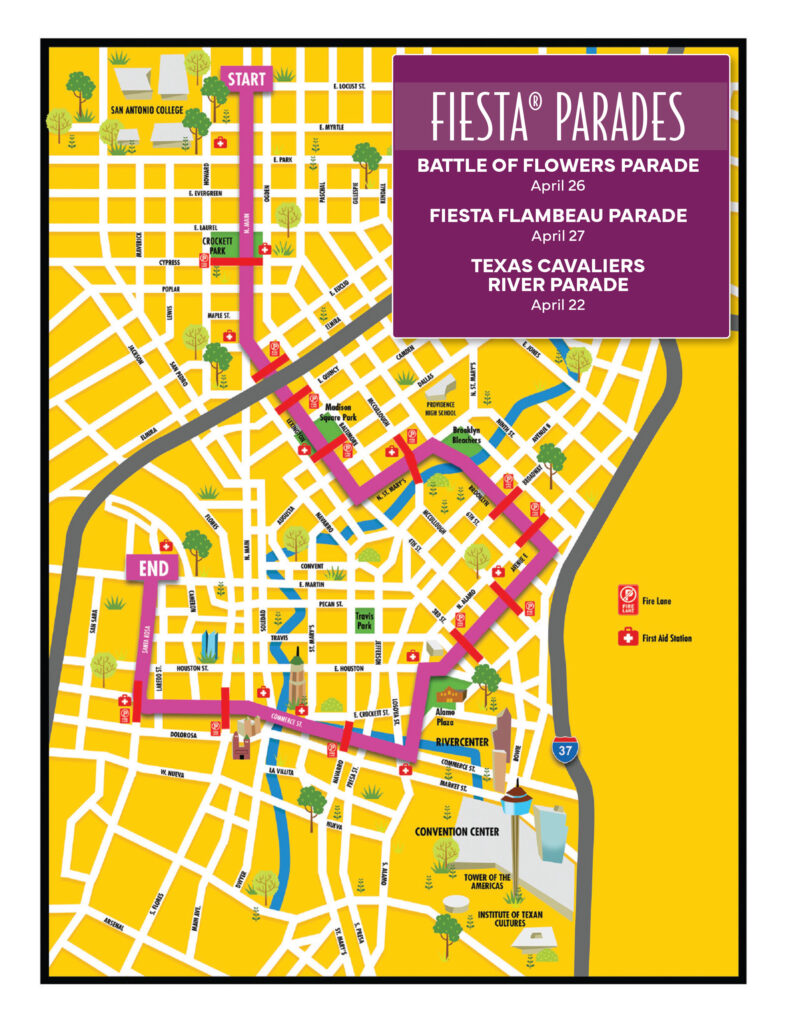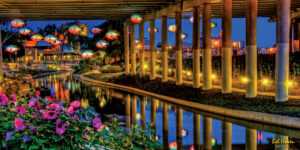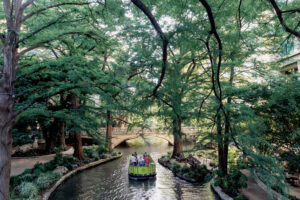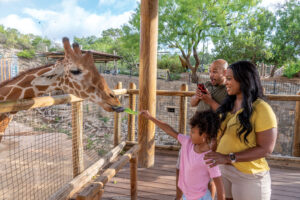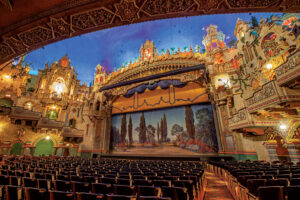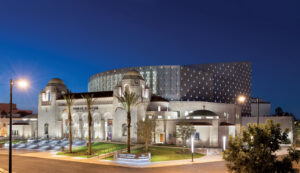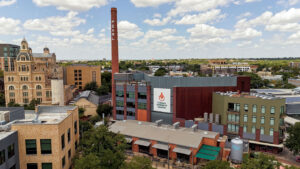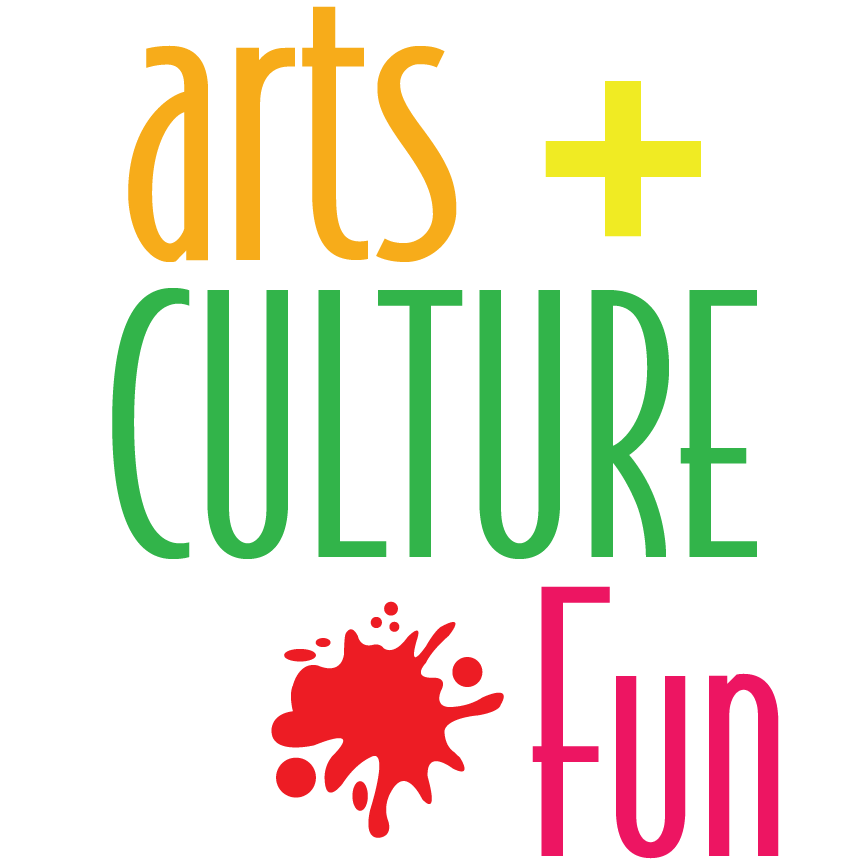¡Viva Fiesta! Every year, the city of San Antonio comes together, flooding the streets, for the Fiesta celebration. The occasion is marked by adorning flower crowns, cracking cascarones and, of course, waiting in line for a chicken-on-a-stick. The festivities are fun, but how they came about offers a unique glimpse into the city’s history, culture and community. Let’s take a trip back in time (all the way back to 1891, in fact) as we wait for the parade floats to round the corner.
The Texas Cavaliers River Parade
Rolling Monday, April 22
The Texas Cavaliers River Parade is making its way down the river for the 78th time this year. This kickoff parade of Fiesta happens each year on the first Monday of the festivities. Over 250,000 spectators line the banks of the River Walk, crowd on bridges, and tune into the city’s live broadcast to get a glimpse of more than 45 lively floats that make their way down the river, bringing music, confetti and fun along the way. But who are these dashing Cavaliers in blue jackets, and how did the parade come to be?
The Texas Cavaliers were formed in 1926 by John B. Carrington, over 15 years before they’d roll their first parade. The original 19 members came together as a social group to promote equestrian tradition at a time when automobiles started taking over the roads. Over time, the emphasis on the horsemanship mission waned as downtown inevitably filled with cars. However, the Mounted Platoon was reestablished in 1984 and today includes over 100 members who guard the Cavalier monarch, King Antonio, as he rides in The Battle of Flowers parade. (More on that later.)
Now, about this king. King Antonio leads the Cavaliers. The royal honor has been bestowed since 1927 when Sterling Clinton Burke was elected to attend the first King’s Ball and preside over city-wide Fiesta events. There has been a king every subsequent year except during World War II. King Antonio’s modern duties include distributing charitable funds, recognizing military troops, and presiding over 10 days of Fiesta fun!
Today, the 500 Cavaliers are made up of local business and community leaders dedicated to promoting and preserving the bravery and independence of the Battle of the Alamo heroes. The organization grew from its social club roots, adopting a charity mission to do good in the community. The Texas Cavaliers Charitable Foundation was formed in 1989 and has since donated over $8 million to Texas charities focusing on local youth.
The Cavalier’s first parade rolled in 1941, coinciding with the completed River Walk revival project designed by architect Robert H.H. Hugman and carried out by President Roosevelt’s Works Progress Administration. The design overhaul created the River Walk we know and love today, including its winding sidewalks and the Arneson River Theatre, where the parade celebrates its finale.
The first parade featured river barges decorated with flowers and bright colors representing local schools, businesses, civic organizations and the army. The idea of these flower-adorned floats was born from a group of Cavaliers who took a trip to Mexico City and were captivated by the floating gardens, which featured dozens of small barges clad in flowers. Through the years, the Texas Cavaliers River Parade has only gotten larger and more colorful, making it a Fiesta staple and cornerstone of San Antonio culture.
Texas Cavaliers River Parade
www.TexasCavaliers.org
The Battle of Flowers® Parade
Rolling Friday, April 26
The Battle of Flowers Parade is rolling its 133rd parade this year. That’s over a century of locals yelling, “Show us your shoes!” and lining the streets of downtown to catch a glimpse of the balloons, flowery floats, and bedazzled cowboy boots and chanclas under royal dress trains. With 10,000 participants and 500,000 spectators, The Battle of Flowers Parade is one of the most popular Fiesta events. What you may not know is that it was also the first. Without it, there wouldn’t even be a Fiesta!
It all began on April 24, 1891, when congressman James L. Slayden’s wife, Ellen Maury Slayden, sought to honor the Alamo’s heroes and commemorate the victory at San Jacinto, where Texas gained its independence from Mexico.
Here’s a little history lesson and backstory. On the dawn of March 6, 1836, General Antonio de Santa Anna of Mexico stormed the Alamo, overtaking the fort and killing over 180 Texas defenders, including legends like Davy Crockett. Seven weeks later, Texans avenged the heroes of the Alamo, defeating the Mexican army at San Jacinto and winning Texas independence.
The very first Battle of Flowers Parade was delayed four days due to unexpected rain. Luckily, the Texas spirit persisted, and these women couldn’t be stopped. Taking inspiration from the flower parades of Spain, Ellen led a group of women who would become the founding members of The Battle of Flowers Association in decorating horse-drawn wagons with fresh-cut flowers. It was said that the women threw flower blossoms at each other in front of the Alamo, re-enacting the famous battle.
From there, the celebration only continued to grow. In 1901, the San Antonio Express-News reported that The Battle of Flowers Parade was the first in the nation to include horseless vehicles. By 1914, the group became official, adopting a constitution. The State of Texas then awarded the 400 inaugural members a 50-year charter. Just one year later, the parade grew so large that fresh flowers were no longer practical decor, and floats had to be assembled weeks or months in advance. By 1933, the group obtained exclusive rights to build grandstands on Alamo Plaza for droves of spectators to watch in luxury. The Fiesta® San Antonio Commission Inc. was chartered in 1959 to coordinate the annual Fiesta Week Celebration, creating the Fiesta we know and love today.
The Battle of Flowers Parade evolved into one of the oldest and largest parades in the country. Today, The Battle of the Flowers Association is the only all-women, all-volunteer organization producing events of its kind, continuing to grow and shape the Fiesta experience for new generations.
So, why do the crowds scream, “Show us your shoes?” It couldn’t just be from curiosity, right? Well, in some ways, it is! In the original Battle of Flowers courts, float royalty would dress up in elaborate gowns and high heels. But as the parade got longer, the women participating wanted to be more comfortable. So, they’d wear cowboy boots, sneakers and even slippers under their long flowing dresses. Once the tradition started, participants would step up their game every year, adorning more elaborate and festive footwear the crowds just had to catch a glimpse of!
Battle of Flowers Parade Association
www.BattleofFlowers.org
THE FIESTA FLAMBEAU PARADE
Rolling Saturday, April 27
Established in 1948, the Fiesta Flambeau Parade is the youngest of the three. However, it may just shine the brightest. After all, the Fiesta Flambeau Parade Association has had 76 years of practice lighting the streets with its illuminated floats. The largest night parade in the country, Fiesta Flambeau runs a 2.6-mile route through the city lined by an audience of over 750,000, plus another 1.5 million watching at home on their television sets. The night parade is one of the most anticipated events of Fiesta. It has even been named one of the “Best in the World” by the International Festivals and Events Association. But whose idea was it to run a parade at night and devise a fun way for spectators to see the action?
The idea of a torchlit night parade was born by San Antonio resident and civil engineer Reynolds Andricks. In 1948, interest in Fiesta fell flat. It had been over 50 years since Ellen Maury Slayden’s Battle of Flowers Parade first rolled, and the years of WWII had cast a shadow over the festivities. People needed something new to reignite the Fiesta spirit, and Andricks had just the thing — a night parade. While other Fiesta activities took place during the day, a night parade guided by torches would bring much-needed revelry to the Fiesta evenings.
Despite not knowing anything about how to throw a parade, he was elected to the Board of the Fiesta San Jacinto Association to put his idea into action. However, he did have the inspiration of another famous parade city to fall back on — New Orleans. Andricks had attended Mardi Gras many times and was inspired by the night parades that rolled through the French Quarter and Garden District. Paraders carried “flambeaus,” French for torches, casting a magical, starry glow on the floats, bands and horses. Of course, he wanted to do it bigger with a Texas spin.
So, he called in the local expert, a Fredericksburg man by the name of William Petmecky. Petmecky earned the reputation of “FestivalImpresario,” creating numerous Hill Country festivals, including the Easter Fires Pageant. He had the experience and understood the vision. Together, the duo would pull off what would become the largest illuminated night parade in America. While the first parade was made up of torchbearers, equestrians and carriages, today’s lineup includes more than 200 entries. The streets now light up with LED floats, local bands and decked-out cars thanks to the 65 association members and 300 annual volunteers who make it all possible. Of course, the classic flambeaus still guide the way!
However, there is a newer member of the Flambeau crew who has taken charge of leading the pack and spreading Fiesta cheer year-round. Meet Torchy, the Fiesta Flambeau mascot who joined the team in 2006. Torchy has played a big role in shedding light on the community and also helping kids in need. In 2015, the association established a charitable component, and Torchy represents it well. He visits local hospitals and schools, spreading the message of literacy and education to empower the future generation of Fiesta goers.
Fiesta Flambeau Parade Association
www.flambeau.org


